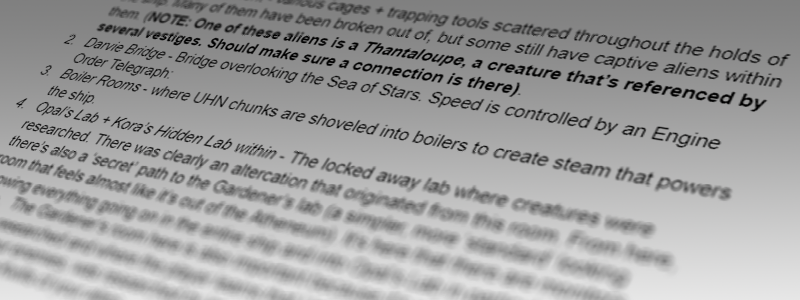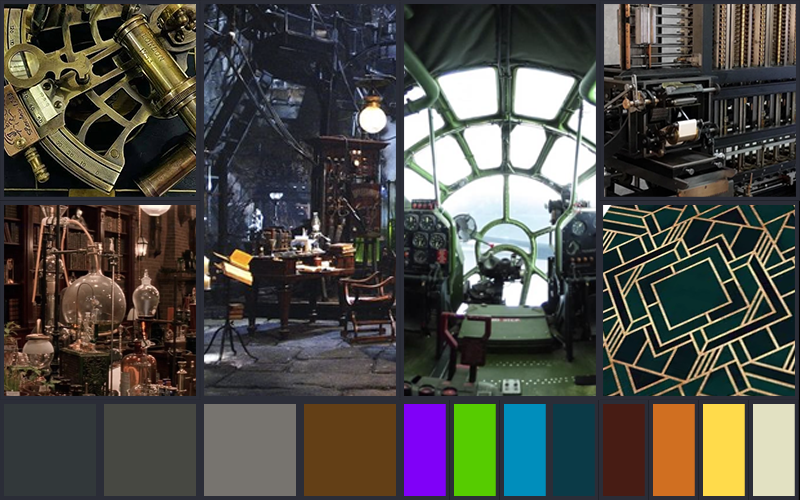GENESIS
Each Book begins with an idea, and from that idea grows the story. Our writer/loremaster, Brendan, who is in charge of all things story and book-related, will decide on the new book location and create the story that is written within. Art and Design will then sync on the idea, making sure all the lore and reference is understood and Art is ready to proceed with concepts for the new book. We discuss the story behind the world, how it fits in the overall narrative, who and what you meet there, and what it should look like. This also includes things like new enemies, weapons, outfits, and NPC’s.

REFERENCE
Once we have a clear vision for the book, reference is gathered based on the location and atmosphere specified in the creative brief. In this case, the setting for the Starship of Terrors takes place on the DARVe, a space-faring vessel that collects, catalogs and experiments on alien creatures. Since we’re going for a 30’s style “art deco sci fi” look and feel, we checked out a lot of art deco architecture, pulp sci-fi, and classic creature features, as well as different environmental references such as laboratory equipment, animal containment, and ship mechanics like boilers, engines, and turbines.
Brendan put a fun twist on the ship itself and requested it be more of an airship, floating through gaseous, ether-like space. That meant we could design it with more specific features like rigid sails, tension lines, and propellers. Along with the physical reference, this is also where we begin to decide the color palette and what mood we want to establish using those colors.

FOUNDATION
A little background on the creative strategy behind each Book is helpful here. When developing the style of the game, we wanted to make sure gameplay came first. The most important thing for the player to focus on is the combat, and all the various art elements follow a very strict order of priority. The characters, weapons, and enemies are first in the hierarchy, with high levels of detail and more complex silhouettes. The UI and VFX follow, since those are the key points of feedback for the player. The environment that everything is situated in is designed to support (but not distract from) the flow of gameplay, so the worlds themselves are built with an emphasis on color and shapes.
The art style of Inkbound is colorful, fantastical, and dreamlike. Not too realistic or complex to distract from what the player is doing, but with enough unique silhouettes, color, and detail to create the setting and help tell the story as the player moves through each world. These are all things we keep in mind when approaching the design of a new Book.
CONCEPT
The concept process begins with rough sketches and model blockouts of various areas or pieces of the environment. Since every asset in the game helps tell the story visually, careful attention is paid to the details and why things look the way they do. What happened to the ship? What creature was kept in this cage that could tear it open so easily? From bones on the floor to the books that line the shelves and every microscope, flask, switch, dial, and steel trap in between, everything is crafted to build a visual narrative.
Working from a quick list of assets is very helpful - big specimen tanks for the aliens, shelves, and equipment for the labs, broken open cages for the containment area, clunky consoles and big glowing screens for the bridge, etc. We wanted to evoke the feeling of a haunted house, with monsters and mysteries hiding around every corner. Details like dirt on the floor, cobwebs strung between equipment and bookshelves, and VFX-like sparks and steam all work to build a creepy sci-fi atmosphere. To make the player feel even more like they’re walking through the bowels of a vessel, the edges of each environment are surrounded by splitting hull plates and huge steel ribs, barely holding the ship together.

SPACES
The DARVe is a complex ship with multiple areas to walk through. Each one needed to feel unique, but still be a part of a whole ship. This is where the color and silhouettes of each environment play a key role, helping each area tell its own part of the story.
- The CREW QUARTERS is the most relatable environment, with carpet, shelves, tables and chairs. The player is introduced to the ship here and begins their journey in this familiar yet spooky area.
- CONTAINMENT is a grimy location where the dirty work is done capturing and keeping aliens (unsuccessfully it would seem due to the amount of broken bars on the cages). Wood and Metal textures play heavily here, combined with trapping equipment and the bones of unfortunate alien critters.
- ENGINEERING keeps the ship afloat, although the years have taken their toll as the spinning dynamos threaten to overload and steaming boilers strain their rivets. Rusted steel and copper plates dominate the color palette, complimented by the magenta light of burning Uhn in this utilitarian zone
- The LABORATORY is where the mad science happens. Sickly green glowing tanks house aliens waiting examination on steel operating tables, surrounded by chemicals and equipment that add to the cluttered, untidy appearance. This is also where the CAPTIVE can be found, falling apart like the rest of the machinery around him.
- The DARVe wouldn’t be complete without the BRIDGE, helping to guide the doomed ship through unknown space. The BRIDGE is more ornate, with decorations surrounding equipment and control screens that glow an eerie blue, and sparks fly from the complex yet antiquated machinery. This technology is barely keeping the ship on course as it slowly falls apart piece by piece on its way through the cosmos.
Once all the pieces are designed and built, the process of constructing each zone can begin and the DARVe begins to take shape, from the very first portal to the final fight with the shape-shifting Mimic.
Thanks for reading and being a part of the world of Inkbound! We look forward to introducing even more worlds for you to explore!

Changed depots in dev-next-season-pending branch